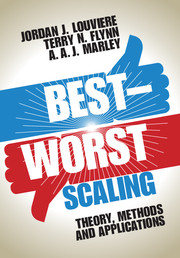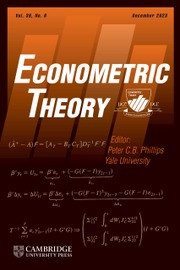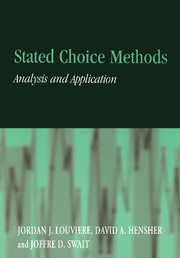Best-Worst Scaling
Best-worst scaling (BWS) is an extension of the method of paired comparison to multiple choices that asks participants to choose both the most and the least attractive options or features from a set of choices. It is an increasingly popular way for academics and practitioners in social science, business, and other disciplines to study and model choice. This book provides an authoritative and systematic treatment of best-worst scaling, introducing readers to the theory and methods for three broad classes of applications. It uses a variety of case studies to illustrate simple but reliable ways to design, implement, apply, and analyze choice data in specific contexts, and showcases the wide range of potential applications across many different disciplines. Best-worst scaling avoids many rating scale problems and will appeal to those wanting to measure subjective quantities with known measurement properties that can be easily interpreted and applied.
- Provides step-by-step guidelines for designing, implementing and analyzing best-worst scaling experiments; provides historical accounts of advantages and disadvantages of methods no longer used; and provides data formatting and set-up for various methods of analysis
- Includes both simple and more advanced (mathematical-based) introductions to the theory; readers can choose how much detail to read into
- Includes various case studies and application illustrations; ranges from simple to more advanced analytical methods
Reviews & endorsements
"Best-Worst Scaling (BWS) has emerged as a novel and innovative method for eliciting preferences and understanding choice behavior. This book provides researchers and practitioners with a clear understanding of the origins, theory, and use of BWS and contains interesting case studies from a range of disciplines. This excellent collection of papers also provides a fascinating story of how a new research method moves from initial ideas to adoption by researchers in multiple fields worldwide. It is a must-have reference for current users or those interested in learning about BWS."
W. L. (Vic) Adamowicz, Department of Resource Economics and Environmental Sociology, and Research Director, Alberta Land Institute, University of Alberta
"This book is an important guide for researchers, marketing practitioners, and anyone else who wants to apply the power of best-worst scaling to improve the measurement of preferences and attitudes. Louviere, Flynn, and Marley show how best-worst scaling is easy to use with standard tools and software, and can supersede conventional ratings-based and discrete-choice surveys. With this book, the great benefits of best-worst scaling are now within easy reach of everyone."
Scott D. Brown, University of Newcastle, Australia
"This is the definitive source work on best-worst scaling - the method is explained and illustrated by its original developers. A must-have for marketing research practitioners, consultants, and academics interested in the latest advances in stated-choice methods."
Robert J. Meyer, Frederick H. Ecker/Metlife Insurance Professor of Marketing and Co-Director, Wharton Center for Risk Management and Decision Processes, The Wharton School, University of Pennsylvania
Product details
October 2015Adobe eBook Reader
9781316309032
0 pages
0kg
49 b/w illus. 130 tables
This ISBN is for an eBook version which is distributed on our behalf by a third party.
Table of Contents
- Preface
- Acknowledgments
- Theory and Methods:
- 1. Introduction and overview of the book
- 2. The BWS object case
- 3. The BWS profile case
- 4. The BWS multi-profile case
- 5. Basic models
- 6. Looking forward
- Applications - Case 1:
- 7. BWS object case application: attitudes towards end-of-life care Terry N. Flynn, Elisabeth Huynh and Charles Corke
- 8. How consumers choose wine: using best-worst scaling across countries Larry Lockshin and Eli Cohen
- 9. Best-worst scaling: an alternative to ratings data Geoffrey N. Soutar, Jillian C. Sweeney and Janet R. McColl-Kennedy
- Applications - Case 2:
- 10. When the ayes don't have it: supplementing an accept/reject DCE with a case 2 best-worst scaling task Richard T. Carson and Jordan J. Louviere
- 11. BWS profile case application: preferences for treatment in dentistry Emma McIntosh and Terry N. Flynn
- 12. BWS profile case application: preferences for quality of life in Australia Terry N. Flynn and Elisabeth Huynh
- Applications - Case 3:
- 13. The stability of aggregate-level preferences in longitudinal discrete choice experiments Towhidul Islam and Jordan J. Louviere
- 14. Case 3 best-worst analysis using delivered pizza and toothpaste examples Bart D. Frischknecht and Jordan J. Louviere
- 15. Using alternative-specific DCE designs and best and worst choices to model choices Jordan J. Louviere
- References
- Subject index
- Author index.





